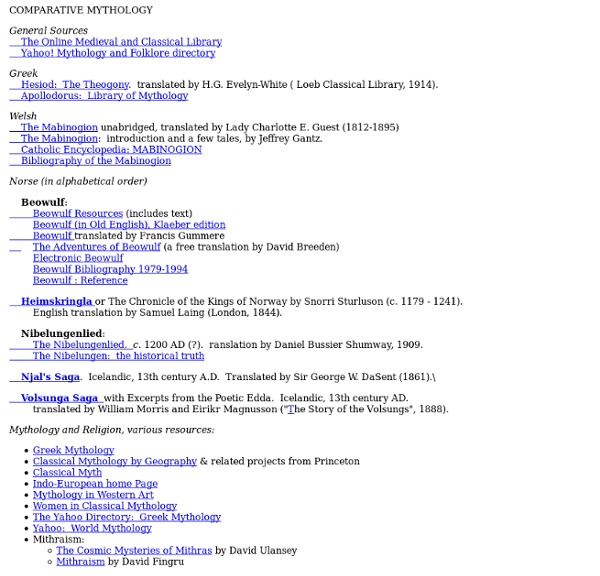



Encyclopedia of Myths Mythologias Godchecker.com - Your Guide To The Gods Family tree of the Greek gods Key: The essential Olympians' names are given in bold font. See also List of Greek mythological figures Notes External links Media related to Family trees of Greek mythology at Wikimedia Commons What Is A Modern Myth? I’ve had many discussions with people over the past few years about why myth is important. Much of these discussions come down to a misunderstanding about what the word “myth” means, so what could have been an interesting discussion about politics, permaculture, literature (or sex or food for that matter) becomes a lesson in semantics. I’d like to avoid rehashing that argument, and toward that end, give a definition of myth that all of us can wrap our heads around. And I hope as a result of it you will see why this is such a crucial issue to explore, as it has relevance in regard to every other discipline of study. First, I’d like to start us off with a short excerpt from the introduction of The Immanence Of Myth (Weaponized press). Modern myths are, quite plainly, alive. We may use myths to explore why something is the way it is, or what we are to do with it, but a given myth remains just an interface. The myth underlies our motive, or at least, it gives it voice. Take a breath.
Chaotic Shiny - RPG-Related Generators What Makes a Hero: Joseph Campbell’s Seminal Monomyth Model for the Eleven Stages of the Hero’s Journey, Animated by Maria Popova “It has always been the prime function of mythology and rite to supply the symbols that carry the human spirit forward.” Nearly four decades before Joseph Campbell (March 26, 1904–October 30, 1987) refined his enduring ideas on how to find your bliss and have fulfilling life, the legendary mythologist penned The Hero with a Thousand Faces (public library) — his seminal theory outlining the common journey of the archetypal hero across a wealth of ancient myths from around the world. Campbell’s monomyth model has since been applied to everything from the lives of great artists to pop-culture classics like Star Wars. But perhaps Campbell’s most important and enduring point from the book has to do not with the mechanics of the hero’s journey but with the very purpose of hero-myths in human life. It has always been the prime function of mythology and rite to supply the symbols that carry the human spirit forward, in counteraction to those that tend to tie it back.
Top 10 Tips : Starting and Finishing the 1st Draft - Rasmus Rasmussen dot com With this year’s Nanowrimo, I will be finishing the first draft of a novel for the fifth time. It’s a great feeling, to reach that last page and set down that last period. Whenever I’ve done that, I always sit and stare blankly at the screen for a while. However, getting there is no picnic. But like the artist starts with a sketch, so does the writer. 01 : Hatch the plot First thing you’ll need is a story to tell. 02 : Understand your characters Take your main characters and write up profiles for them. 03 : It begins with the end J. 04 : Write out scene-cards Try to identify what the main turning points in your story will be and write them down on index cards. 05 : Don’t forget that this is a draft Throughout the writing process, you have to remember that a first draft is just that. 06 : Find your writing space Some prefer to write in the comfort of their home, some like to stay after hours at the office. 07 : Get rid of distractions 08 : Set daily goals and stick to them
Hipsters and Squares: Psychologist Jerome Bruner on Myth, Identity, “Creative Wholeness” and How We Limit Our Happiness by Maria Popova How our cult of creativity, which replaced religion, is becoming a source of anguish rather than happiness. Today, we hang so much of our identity on our capacity to create, often confusing what we do for who we are. And while creativity, by and large, is a positive force in the external world, its blind pursuit can be damaging to the inner. Bruner begins with some essential definitions: Myth … is at once an external reality and the resonance of the internal vicissitudes of man. But while he acknowledges that the central function of myth is “to effect some manner of harmony between the literalities of experience and the night impulses of life,” Bruner cautions against assuming an opposition of the two — of “the grammar of experience and the grammar of myth” — as they are complementary rather than clashing, something best manifested in the relationship between myth and personality. Consider first myth as projection, to use the conventional psychoanalytic term.
Procrastinating Writers